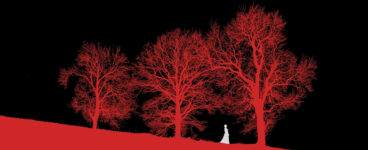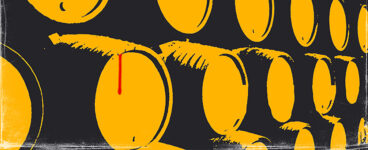‘It had been up to me, alone, to cram these bodies back into their cask coffins, replace the fetid liquid and roll the barrels away.’
When a dilapidated distillery comes up for sale in rural Kintyre, Eilidh and her wife Morag jump at the chance. But their ambition to run the first women-owned whisky distillery in Scotland seems to be scuppered when a grisly, decades-old secret is revealed: two dead bodies have been stuffed into barrels, perfectly preserved in single malt. Enjoy this extract from The Malt Whisky Murders.
The Malt Whisky Murders
By Natalie Jayne Clark
Published by Polygon
Now, here I was, dressed in a beige sweater that wasn’t mine, in Campbeltown, nearly two decades later, with a beautiful wife, proudly bisexual, my very own whisky distillery, replete with a pair of decades-old corpses, with someone asking me questions on camera for the BBC.
‘You’re well known in Scottish whisky circles for your long-running, successful blog “Wisdom in Whisky” and the subsequent prize-nominated book of the same name. Can you tell us more about how that began? Please remember to mention the question in your answer this time.’
‘Yes. Well–’
‘And to look into the camera.’
‘Haha, this is why I have a blog, not a vlog.’ Heather didn’t laugh. I pulled the sleeves of the jumper over my hands and stretched my arms outwards, looking over to the purply water’s edge, as if taking it all in before I tried again.
‘I began my blog “Wisdom in Whisky” while I was still at uni, in Stirling, because it was my obsession at the time. I’d had a few before – just ask my old flatmates about my torrents of tangles of threads during my cross-stitching phase or the period where I didn’t leave my room because I was watching every single Jonestown documentary.’
Heather looked blank. Maybe she didn’t want to hear about that. I hate people who don’t show their thoughts on their faces. I can’t help but do it myself, so it doesn’t seem fair.
‘I tried my first whisky in a new pub that opened up in 2005, in Stirling. I was led through a tasting – a private tasting, essentially – and then I saw it in a whole new light. It was like magic, how something that before simply seemed to all be the same brown liquid now came to me as layers and layers of sensory experience and care. I think it was when I first learned about maturation that I was hooked. ‘The casks, the barrels, add so much depth to the liquid. I love that whatever they held before – sherry, bourbon, port, even whisky – influences the new-make whisky we put inside to mature. Not only that, the casks are toasted to break down the structure of the oak and sugars, and how lightly or heavily you toast the wood creates different flavours again. Some even say the type of soil in which the trees are grown affects the flavours. Distillers might take into account the rainfall of the area of provenance and how the wood was originally dried. That’s all without taking into consideration the size of cask you use, how many times it’s been used before, how long you leave your whisky in there, how many casks you move the whisky between, the weather as it matures and the geography of the area where it lies – even the way the logs were originally cut can affect the final product because of how the wood grain contacts the alcohol. And that’s just one element of the process of whisky creation.’
I was still getting zilch from Heather.
‘My blog though . . . you asked me about that. Essentially, I wasn’t going to my lectures, for a variety of reasons, and I started writing the posts for fun, instead of doing my essays. I was meant to be studying English, because that’s all I was really good at, except after one of the first seminars, your classic “death of the author” one, I became more interested in philosophy. If I’d been more proactive, maybe I might have changed subject and actually finished with a decent grade, but . . .’
I’d forgotten the question. Heather prompted me: ‘Yes, and tell us about the book and blog, please. How did that happen? How did you get noticed?’
‘I had thought it was funny to compare a whisky to a certain philosopher or their, like, policies? No – schools of thought. So, like, an Auchentoshan to Noam Chomsky, or a Glen Livet to Hannah Arendt. It sort of caught on – it was a different way of viewing both the whisky and the philosopher, I think. It grew from there, but the real growth was when I branched out from philosophers to writers and thinkers of any kind and when the comments sections in themselves began containing essays. That was a bit of a wild ride – I started getting invited to things. I got an offer from a publisher too. I had a year to write the book, but really most of it was written in the last month. Anyway, it was, I suppose, semi-successful, as successful as a book can be these days without being Richard Osman or whoever. I moved beyond the pub in Stirling and went to tastings and festivals elsewhere. Most of my student grant went on that, actually. That’s how I met Morag too.’ I looked about for Morag, for some assistance, a nod that confirmed I wasn’t wittering and I was making sense. But she was still dealing with the roofers, who had decided to start charging god knows how much just to survey the buildings before they even began work. I paused and glanced at my interviewer.
Heather was a few years younger than us, someone who seemed to have skipped the awkward, unsure years of her youth and zipped straight to the self-assured I-don’tsmile- for-anyone phase. Morag knew her quite well from her reporting days and told me multiple times how lovely she was and not to read anything into her dour facial expressions.
‘Thanks for that, Eilidh. I think we’ve got all we can outside for today. It’s bloody miserable.’
Like she could talk.
‘So how about we do some inside shots? All those barrels in the warehouse? You’ve not got much else to show for the cameras yet. Maybe find one with a historically significant year on it? How does that sound?’
Yesterday morning, when the roofer arrived early, very conscientious and aware of the awful windy and winding road down from Tarbet, we hadn’t yet put the bodies away. It was Bruno that saved us. Big dopey lovely Bruno. He basically took a running jump onto the man and crashed into him with such force he ended up on his back. Our dog is mostly well-trained, but sometimes he gets excited, and he hadn’t slept much. Neither had we. Morag had taken the roofer, Rodney, to recover with a cup of tea, far away from the warehouse. It had been up to me, alone, to cram these bodies back into their cask coffins, replace the fetid liquid and roll the barrels away.
The Malt Whisky Murders by Natalie Jayne Clark is published by Polygon, priced £9.99.
ALSO IN THIS ISSUE

 The Witch, the Seed and the Scalpel
The Witch, the Seed and the Scalpel
‘Witchcraft,’ said Father. ‘It is said that should any person catch the falling chestnut before it t …

 The Malt Whisky Murders by Natalie Jayne Clark
The Malt Whisky Murders by Natalie Jayne Clark
‘It had been up to me, alone, to cram these bodies back into their cask coffins, replace the fetid l …













